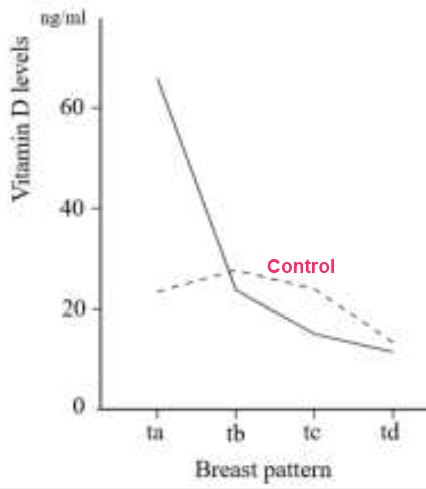Fibrocystic breasts associated with Vitamin D deficiency (2X)
The association between Vitamin D deficiency and fibrocystic breast disorder
Curr Mol Med. 2023 Jun 23. doi: 10.2174/1566524023666230623155659 PDF is behind a paywall
Sheida Shabanian 1, Aliyeh Rozbeh 2, Belgheis Mohammadi 1, Ali Ahmadi 3, Mohammad-Hassan Arjmand 4
Background: The role of deficiency of vitamin D in a wide range of human cancer, including breast cancer, has been proven, but its role in benign breast diseases remains unknown. This study aimed to determine the prevalence of vitamin D deficiency in patients with fibrocystic breast (FB) disease.
Methods: First, the hospital prevalence of fibrocystic breast was determined by a cross-sectional study. Then, patients were divided into two groups by a case-control study; women with confirmed fibrocystic breasts based on breast pain, physical examination, and ultrasonography were included as a case group (N=48) and age-matched women without fibrocystic breasts were also included as a control group (N=48). After recording the demographic and gynecological characteristics and exposure to the sun, gynecological records, and family history of fibrocystic breast, the blood sample was taken to determine vitamin D. Data were analyzed by Stata software.
Results: The result indicated that the studied groups had significant differences in regards to weight, breast pain, the severity of breast pain, breast heaviness, family history of fibrocystic breast, history of breast disease, caffeine consumption, and exposure to sunlight (p <0.05), but did not show significant differences based on age, occupation, education, gynecological history, diabetes mellitus, hypertension, obesity and hypothyroidism, vegetable, fast food, and dairy products consumption.
The frequency of vitamin D deficiency in the case group was 45.8%, and in the control group, it was 20.8%, and there was a statistically significant difference (p <0.05).
Conclusion: Vitamin D deficiency is more common in women with fibrocystic breast disease and may play a role in the development of the disease.
Relationship of blood 25-hydroxy vitamin D level with fibrocystic breast disease and breast density - 2022
Cukurova Medical Journal 2022, Vol: 47 Issue: 1, 161 - 168, 31.03.2022 https://doi.org/10.17826/cumj.1016601
Hacı BOLAT Alirıza ERDOĞAN

Breast Pattern:
Fatty (ta), scattered fibroglandular density (tb), heterogeneously dense (tc), and extremely dense (td)
Purpose: The aim of this study is to evaluate the association of blood 25-hydroxy vitamin D levels with fibrocystic breast masses and breast patterns.
Materials and Methods: The study included 612 patients who presented with breast complaints or referred for routine screening between 2018-2021 and were requested to have breast ultrasonography (USG) and mammography (MG) examinations. Patients were divided into two groups; group 1 consisted of women with fibrocystic mass (BI-RADS 2-3) and group 2 consisted of women without breast mass (BI-RADS 1). These two groups were compared by age, breast USG, MG results, and blood 25-hydroxy vitamin D levels.
Results: Of the 612 patients, 310 (51%) had fibrocystic mass in their breasts, while 302 (49%) had normal breasts. The mean age of both groups was similar. Those with fibrocystic mass in the breast had lower vitamin D levels and higher breast density than the control group. The group with higher breast density had lower vitamin D levels, and there was a negative correlation between vitamin D level and breast density
Conclusion: Our study revealed that women with fibrocystic masses in their breasts (BI- RADS2 and BI-RADS3) had higher breast density and lower vitamin D levels than women without breast mass.
📄 Download the PDF from VitaminDWiki
